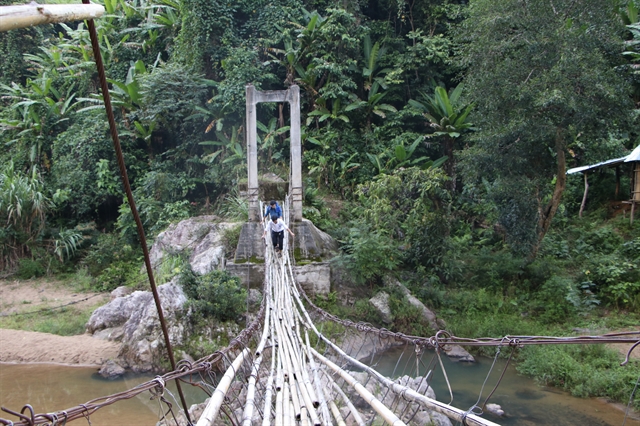 Society
Society


|
| Teachers cross a suspension bridge to visit Nước Mù Village in the central province of Quảng Ngãi. — VNA/VNS Photo Đinh Thị Hương |
Đinh Thị Hương
QUẢNG NGÃI — Nguyễn Văn Ánh, principal of Sơn Bua Primary and Secondary School, in the central province of Quảng Ngãi, walks about 3 kilometres on steep, dirt tracks and crosses a wooden bridge to Nước Mù Village to urge underprivileged students to go to school.
The village, about 4 kilometres from Sơn Bua Commune, Sơn Tây District – a remote and mountainous area of the province – has 16 households with 25 children.
The journey takes Ánh one hour.
Ánh said the new school year started nearly a month ago, but 20 students from the village are yet to return to school.
“Parents of the children are illiterate as well as too busy with farming, so they pay little attention to whether their children are going to school or not,” he said.
Đinh Văn Núi, a resident of the village, has 10 children, including seven of school age.
However, when Ánh visited Núi’s house, only one kid was attending class. The six others were at home.
Núi said he took all children to school at the beginning of the week. But maybe they were homesick, so they came home.
When seeing Ánh at their house, the children hid.
Ánh said: “Go to school tomorrow, there are lots of new textbooks and clothes. If you stay at school until the weekend, I will give you food.”
Leaving Núi’s house, Ánh visited Đinh Y Mới – a mother of a fifth-grade girl.
Mới recently moved to the village and did not know how to send her daughter to school.
Ánh told Mới to bring her daughter the following day so they could complete admission procedures.
According to Ánh, the dilapidated wooden bridge was another reason for kids to skip school. Many families felt the bridge was too dangerous to cross.
Spanning about 110 metres, the bridge collapsed and was swept away by flooding several years ago. The district’s Agriculture and Rural Development Office and the provincial Youth Union helped rebuild it.
However, due to recent flooding and storms, the suspension bridge was badly damaged. The bridge shook whenever a person crosses it, he said.
Therefore, Ánh and his collages often had to come to the students’ houses to encourage them to return to school.
Treat students like children
The school has a total of 422 students; including 200 who stay at the school.
Teachers not only teach the children but also serve meals, bathe them and take care of them at night, Ánh said.
Nguyễn Tấn Đức, a teacher, said allowing students to stay at the school started a few years ago. The plan aimed to help students continue their studies without needing to travel home, he said.
However, it also meant a lot of additional work for the teachers, Đức said.
The school now has no staff in charge of providing meals and taking care of the students.
“Teachers have to take turns to help them,” he said.
The teachers also have to look after the children at night when they sleep.
Principal Ánh said to help mountainous and remote communities access education, it would require great efforts from teachers.
"It’s not only hard work, but also dedication and enthusiasm," he said.
Teaching the students was as difficult as the journey over dirt tracks and perilous bridges, he said.
“But we still dedicate ourselves to offer the children a brighter future,” Ánh said.— VNS




